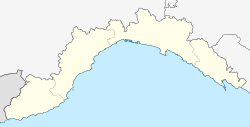Diano Castello
Dian Castello | |
|---|---|
| Comune di Diano Castello | |
 Church of Nicholas of Bari | |
| Coordinates: 43°55′N 8°4′E / 43.917°N 8.067°E | |
| Country | Italy |
| Region | Liguria |
| Province | Province of Imperia (IM) |
| Area | |
| • Total | 6.0 km2 (2.3 sq mi) |
| Population (Dec. 2004)[2] | |
| • Total | 2,061 |
| • Density | 340/km2 (890/sq mi) |
| Time zone | UTC+1 (CET) |
| • Summer (DST) | UTC+2 (CEST) |
| Postal code | 18010 |
| Dialing code | 0183 |
Diano Castello (Ligurian: Dian Castello[3]) is a comune (municipality) in the Province of Imperia in the Italian region Liguria, located about 90 kilometres (56 mi) southwest of Genoa and about 5 kilometres (3 mi) northeast of Imperia. As of 31 December 2004, it had a population of 2,061 and an area of 6.0 square kilometres (2.3 sq mi).[4]
Diano Castello borders the following municipalities: Diano Arentino, Diano Marina, Diano San Pietro, Imperia, and San Bartolomeo al Mare. The hills surrounding the village are covered with olive groves and with vineyards that produce Vermentino, a white wine. It is one of I Borghi più belli d'Italia ("The most beautiful villages of Italy").[5]







